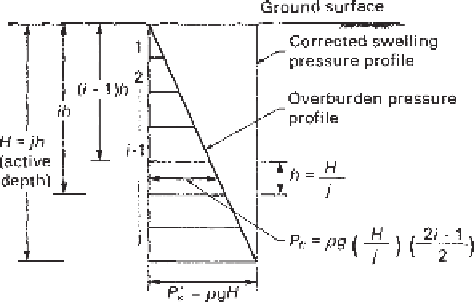Environmental Engineering Reference
In-Depth Information
14.5.10 Parametric Analysis to Illustrate
Influence of Various Variables
The following sections discuss the role of each variable that
controls the magnitude of total heave (Rao et al., 1988). The
corrected swelling pressure and the swelling index are the
main variables which are considered. The effect of correct-
ing the swelling pressure for sampling disturbance on the
prediction of heave is illustrated. A simple geometry with
constant soil properties, including the swelling pressure, is
used for the analyses. The influence of each controlling vari-
able on the prediction of heave can readily be identified.
The same example is also used to illustrate the percent-
ages of heave resulting from the wetting of an expansive
soil to various depths. The analysis can be used to identify
the critical zone where maximum heave will occur. Partial
removal of expansive soils is often attempted in order to
reduce heave potential. The effectiveness of this procedure
in reducing the amount of heave is discussed using the same
example problem.
the corrected swelling pressure equals the total overburden
pressure is defined as the
active depth
of swelling,
H
:
P
S
ρg
H
=
(14.21)
where:
H
=
active depth of swelling,
ρ
=
total density of the soil which is assumed to remain
constant with depth, and
g
=
gravitational acceleration.
Inherent in this definition of active depth is the assump-
tion that the final pore-water pressures throughout the profile
go to zero. Also inherent are the assumptions that there is
sufficient water to wet the entire soil strata and there is suffi-
cient time for the water to infiltrate the entire soil strata. The
heave analysis can be performed by subdividing the com-
puted active depth into
j
number of layers of equal thickness
(i.e.,
h
i
=
h
):
14.5.11 Closed-Form Heave Equation When Swelling
Pressure Is Constant
An example is shown in Fig. 14.43 where the corrected
swelling pressure
P
s
is constant with depth. The soil is
assumed to be homogeneous (i.e.,
e
0
,
ρ
, and
C
s
are constant
with depth). These assumptions apply to the cases presented
in the following sections. Sufficient water is supplied to the
soil such that the pore-water pressures are assumed to go
to zero throughout the entire soil profile. The final stress
state
P
f
H
j
h
=
(14.22)
where:
h
=
thickness of a soil layer.
An analysis is first made to determine the number of lay-
ers required to accurately predict total heave. The initial
stress state
P
0
i
is equal to the corrected swelling pressure
P
s
,
which can be defined in terms of the active depth in
Eq. 14.21:
is assumed to be equal to the total overburden
pressure.
The unsaturated, expansive soil swells upon wetting. Most
of the heave will occur near ground surface where there is
the largest difference between the corrected swelling pres-
sure and the total overburden pressure. Heave continues to
occur until a depth is reached where there is no differ-
ence between the corrected swelling pressure and the total
overburden pressure. In this context, the depth at which
P
0
i
=
ρ
gH
(14.23)
The final stress state
P
fi
in the
i
th layer from ground sur-
face is computed as the average overburden pressure in the
soil layer:
ρg
(i
−
1
)h
+
ih
P
fi
=
(14.24)
2
where:
i
=
soil layer number (i.e., 1, 2,
...
,
j
).
The thickness of the soil layer,
h
, in the above equation
can be written in terms of the total thickness divided by the
number of layers (i.e., using Eq. 14.22):
ρ
gH
(
2
i
−
1
)
P
fi
=
(14.25)
2
j
The heave equation can be written for each soil layer and
then summed to give the total heave. The amount of heave
in each layer can be computed by substituting Eqs. 14.22,
Figure 14.43
Overburden and swelling pressure distributions ver-
sus depth for the case of constant swelling pressure with depth.














Search WWH ::

Custom Search